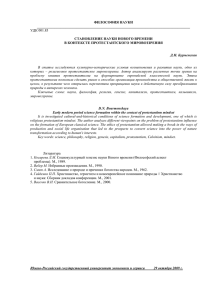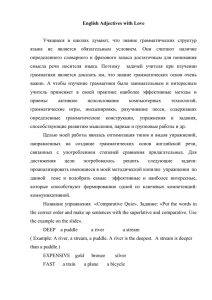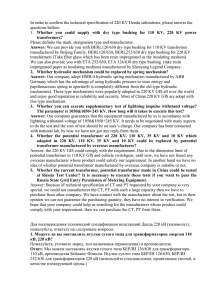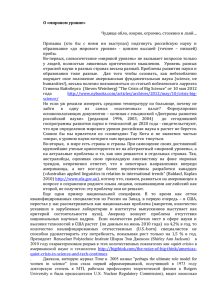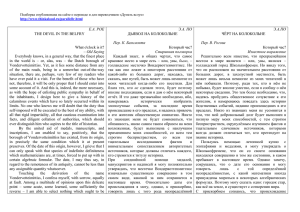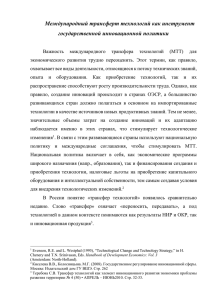Целесообразность научного музея
реклама
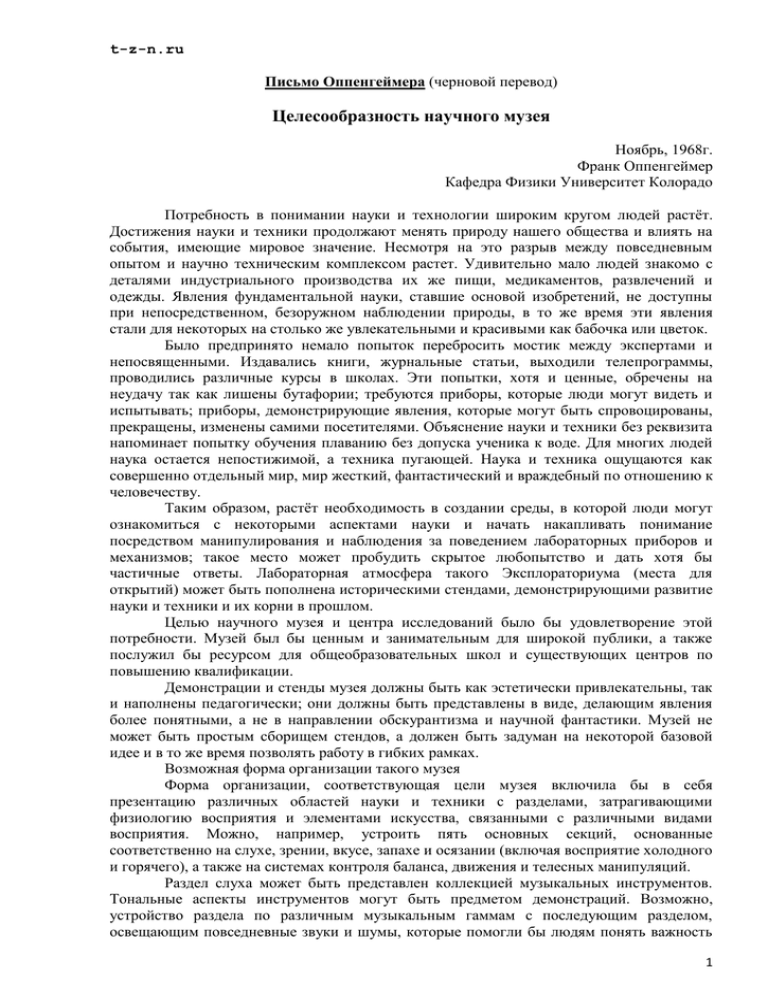
t-z-n.ru Письмо Оппенгеймера (черновой перевод) Целесообразность научного музея Ноябрь, 1968г. Франк Оппенгеймер Кафедра Физики Университет Колорадо Потребность в понимании науки и технологии широким кругом людей растѐт. Достижения науки и техники продолжают менять природу нашего общества и влиять на события, имеющие мировое значение. Несмотря на это разрыв между повседневным опытом и научно техническим комплексом растет. Удивительно мало людей знакомо с деталями индустриального производства их же пищи, медикаментов, развлечений и одежды. Явления фундаментальной науки, ставшие основой изобретений, не доступны при непосредственном, безоружном наблюдении природы, в то же время эти явления стали для некоторых на столько же увлекательными и красивыми как бабочка или цветок. Было предпринято немало попыток перебросить мостик между экспертами и непосвященными. Издавались книги, журнальные статьи, выходили телепрограммы, проводились различные курсы в школах. Эти попытки, хотя и ценные, обречены на неудачу так как лишены бутафории; требуются приборы, которые люди могут видеть и испытывать; приборы, демонстрирующие явления, которые могут быть спровоцированы, прекращены, изменены самими посетителями. Объяснение науки и техники без реквизита напоминает попытку обучения плаванию без допуска ученика к воде. Для многих людей наука остается непостижимой, а техника пугающей. Наука и техника ощущаются как совершенно отдельный мир, мир жесткий, фантастический и враждебный по отношению к человечеству. Таким образом, растѐт необходимость в создании среды, в которой люди могут ознакомиться с некоторыми аспектами науки и начать накапливать понимание посредством манипулирования и наблюдения за поведением лабораторных приборов и механизмов; такое место может пробудить скрытое любопытство и дать хотя бы частичные ответы. Лабораторная атмосфера такого Эксплораториума (места для открытий) может быть пополнена историческими стендами, демонстрирующими развитие науки и техники и их корни в прошлом. Целью научного музея и центра исследований было бы удовлетворение этой потребности. Музей был бы ценным и занимательным для широкой публики, а также послужил бы ресурсом для общеобразовательных школ и существующих центров по повышению квалификации. Демонстрации и стенды музея должны быть как эстетически привлекательны, так и наполнены педагогически; они должны быть представлены в виде, делающим явления более понятными, а не в направлении обскурантизма и научной фантастики. Музей не может быть простым сборищем стендов, а должен быть задуман на некоторой базовой идее и в то же время позволять работу в гибких рамках. Возможная форма организации такого музея Форма организации, соответствующая цели музея включила бы в себя презентацию различных областей науки и техники с разделами, затрагивающими физиологию восприятия и элементами искусства, связанными с различными видами восприятия. Можно, например, устроить пять основных секций, основанные соответственно на слухе, зрении, вкусе, запахе и осязании (включая восприятие холодного и горячего), а также на системах контроля баланса, движения и телесных манипуляций. Раздел слуха может быть представлен коллекцией музыкальных инструментов. Тональные аспекты инструментов могут быть предметом демонстраций. Возможно, устройство раздела по различным музыкальным гаммам с последующим разделом, освещающим повседневные звуки и шумы, которые помогли бы людям понять важность 1 t-z-n.ru задач распознавания звука и памяти. Детали слухового восприятия могут затем быть исследованы с помощью экспериментов по частоте и громкости и определению направления звука и т.д. Далее нить исследования может быть разделена на два направления, одно исследовало бы физику звука, а именно изучение колебаний, резонанса, интерференции и отражений, другое затронуло бы физиологию и гистологию уха и, связанной с ним центральной нервной системы. Заключительная секция в этой цепи могла бы проливать свет на технологию и индустриальные методы, занятые в воспроизводстве звука (таким образом, будет вводиться электроника), конструкцию динамиков и микрофонов, акустику залов различных приспособлений как, например, аппараты для глухих, телефоны, радио, гидролокатор и др. В области зрения, можно было бы начать с живописи и ввести понятие перспективы. Далее можно было бы перейти к явлениям физиологии визуального восприятия, а затем ввести свет, как раздел физики с одной стороны и биологию глаза с другой. Каждое из этих направлений затем должно быть развито до объяснения соответствующих технологий. Затем могло бы быть включено производство красителей, оптические инструменты, производство стекла, телевидение и фотография, освещение, инфракрасные и ультрафиолетовые приборы и лазеры. Возможно, уместно было бы продемонстрировать использование излучений высокой энергии на биологические ткани и другие аспекты медицинских технологий. Подобным образом можно было бы работать с чувствами вкуса и запаха, начиная с пищи и духов, затем развивая некоторые аспекты химии и заканчивая огромной и таинственной областью технологий пищевой и косметической промышленностей. Четвертый раздел можно было бы начать с рассмотрения одежды и жилища, переходя потом от восприятия горячего, холодного и шероховатого к физике тепла и закончить промышленным производством полимеров и строительных материалов. И, наконец, раздел по координации включил бы в себя танцы, атлетику и разнообразные навыки, как то балансирование шестов на одном пальце или управление велосипедом. Это могло бы продемонстрировать возможности координации человеческого тела, затем мог бы быть осуществлѐн переход к механизмам обратной связи и физиологии мускулов и нервов и т.д., закончилась бы эта цепочка сложной техникой механизмов контроля в индустрии. Предложенный план организации музея является лишь одним из многих возможных планов. Я думаю, такой музей привлѐк бы внимание многих, а также предоставил бы образец, которому могли бы подражать другие музеи. Хотя и кажется важным структурирование музея согласно некоему плану подобному предложенному выше, не менее важно чтобы посетители музея были бы свободны от строго предначертанных путей. В предложенном музее некоторые могут проследить чувственное восприятие, переходя от одного раздела к другому. Одни посетители могут задержаться в одном из разделов, например физике звука или производстве пищи, в то время как другие предпочтут побродить случайным образом из зала в зал. Первые шаги Дизайн и постройка изящных, ясных и пригодных для использования широкой публикой установок и стендов будет происходить медленно. Очень может быть, что постройка проекта, очерченного выше, займѐт много лет. Однако, некоторые программы должны быть запущены быстро, а в последствии быть постоянными составными частями музея. 1. Школьные научные ярмарки. Такие ярмарки на сегодняшний день уже являются установившимся явлением. Однако проекты выставляются там на один два дня, затем разбираются и складываются в хранилища. Было бы очень хорошо, если бы они выставлялись на более длительные периоды, а ученики, построившие их, иногда могли бы находиться в музее для объяснения посетителям своих стендов. В будущем талант и усилия, создавшие эти проекты, могли бы быть расширены для проектирования выставок более высокого уровня для музея. 2 t-z-n.ru 2. Установки, используемые в образовательных научных телепрограммах, после показа по телевидению могли бы демонстрироваться в музее. Со временем, телевизионная студия могла бы стать частью музея и взаимосвязь между музеем и телевидением могла бы развиваться. 3. Имеется необходимость в одном центральном месте для показа лабораторных установок разработанных в школах и институтах. Приборы должны быть расположены таким образом, чтобы учителя и их ученики могли с ними работать. В этом могут посодействовать как производители этих приборов, так и Фонд Национальной Науки, которые уже немало вложили в их разработку. 4. Существует множество вещей, как на производстве, так и в науке, которые сами по себе прекрасны, когда их показывают не для педагогических целей. Факультет искусств Стэндфордского университета недавно собрал выставку, используя аппаратуру Стэндфордского линейного ускорителя. Такая выставка могла бы быть ценной экспозицией и выглядеть довольно естественно, как, например, выглядят скульптуры в садах или в смежных с музеем зданиях. Музей не должен заменять школу или занятия, но он может быть местом, куда люди приходят и чтобы учить, и чтобы учиться. Посетители должны находить это освежающим их знания и представления. И, прежде всего, все должно быть искренним и давать понятие о глубине влияния науки и технологии на человеческие ценности и стремления. Письмо Оппенгеймера (подлинник) Reprinted from Curator November 1968 For Palace of Arts & Science A Rationale For a Science Museum Frank Oppenheimer Department of Physics University of Colorado There is an increasing need to develop public understanding of science and technology. The fruits of science and the products of technology continue to shape the nature of our society and to influence events which have a world-wide significance. Yet the gulf between the daily lives and experience of most people and the complexity of science and technology is widening. Remarkably few individuals are familiar with the details of the industrial processes involved in their food, their medicine? Their entertainment or their clothing. The phenomena of basic science which have become the raw material of invention are not easily accessible by the direct and unaided observation of nature yet they are natural phenomena which have, for one segment of society, become as intriguing and as beautiful as a butterfly or a flower. There have been many attempts to bridge the gap between the experts and the laymen. The attempts have involved books, magazine articles, television programs and general science courses in schools. But such attempts, although valuable, are at a disadvantage because they lack props; they require apparatus which people can see and handle and which display phenomena which people can turn on and off and vary at will. Explaining science and technology without props can resemble an attempt to tell what it is like to swim without ever letting a person near the water. For many people science is incomprehensible and technology frightening. They perceive these as separate worlds that are harsh, fantastic and hostile to humanity. There is thus a growing need for an environment in which people can become familiar with the details of science and technology and begin to gain some understanding by controlling and watching the behavior of laboratory apparatus and machinery; such a place can arouse their latent curiosity and can provide at least partial answers. The laboratory atmosphere of such an 3 t-z-n.ru «Exploratorium» could then be supplemented with historical displays showing the development of both science and technology and its roots in the past. The purpose of a science museum and exploration center would be to satisfy this need. It could be valuable and entertaining fir the general public and would serve as a resource for schools and existing adult education programs. The demonstrations and exhibits of the museum should have an aesthetic appeal as well as pedagogical purpose and they should be designed to make things clearer rather than to cultivate obscurantism or science fiction. The museum cannot be a mere hodge-podge of exhibits but should be conceived with some basic rationale that can provide a flexible framework. A possible form of organization for such a science museum A form of organization which could help fulfill the underlying purpose of the museum would involve introducing the various areas of science and technology with sections dealing with the psychology of perception and the artistry associated with the various areas of perception. One might, for example, have five main sections based respectively on hearing, on vision, on taste and smell, on the tactile sensations (including perception of hot and cold) and on propriosensitive controls which form the basis of balance, locomotion and manipulation. The section on hearing might be introduced with a collection of musical instruments. The tonal qualities of the instruments could be demonstrated or reproduced. There could be a section on various musical scales, followed by a section on everyday sounds and noises which could make people aware of the problems of sound recognition and memory. The derails of auditory perception could than be explored with experiments on the frequency and loudness response range and on the determination of sound direction, etc. The thread could then divide in two. One part would explore the physics of sound, that is the study of vibrations, oscillations, resonance, interference and reflections. The other part would be the physiology and histology of the ear and the associated central nervous system. The final section would then elucidate the technology and the industrial techniques involved in sound reproduction, (thus introducing electronics) speaker and microphone construction, the acoustics of auditoriums and various devices such as hearing aids, telephones, radio, sonar, and the like. With the sense of vision one might start with painting and introduce the ideas of perspective and the effects involved in op-art and moire patterns. One would move to experiments in the psychology of visual perception and then branch to the physics of light on the one hand and to the biology of the eye on the other. These would each then lead to technology. The technology might include pigment manufacture, optical instruments, glass manufacture, television and photography, lighting, infrared and ultraviolet devices and lasers. It might even be appropriate to demonstrate the use of high energy radiation on biological tissue and other aspects of medical technology. One would proceed in a similar fashion with taste and smell starting with food and perfume, then developing some aspects of chemistry and ending with the vast and mysterious technology of the food and cosmetic industries. The fourth section would start with clothing and housing, pass through a section on perception of hot and cold and roughness, and then develop the physics of heat and lead to the section on industrial production of fibers and building materials. Finally, the section on control would involve dancing and athletics and various skills such as balancing rods on one’s fingers or riding a bicycle. It would demonstrate the propriosensitive mechanisms of the body and would then branch to the mathematics of feedback mechanisms and the physiology of muscles and nerves and the semicircular canals, etc. and end up with the sophisticated technology of control mechanisms in industry and technology. This form of organization is but one of many possible plans for a museum. I believe it would capture the interest of many people and might provide a pattern which museums might wish to follow. However, although it seems essential that the museum be structured according to some underlying plan such as the one suggested above, it is also important that the people who use the museum not be forced to follow some preconceived pattern. In the proposed organization some people might be interested in following the domain of perception from one area to another. 4 t-z-n.ru Some might remain rooted in just one area such as in the physics of sound or in food technology, whereas others may want to wander around the halls at random. Immediate programs The design and building of elegant, clear and reasonably public-proof experiments and exhibits will proceed slowly. It might easily take many years to complete the type and displays for the program outlined above. There are, however, some programs which could be initiated within a short time and which should be continuing features of the museum. These are outlined below. 1. School science fairs have become established institutions. At present, however, the projects are displayed for only two or three days and are then dismantled or returned to some storage place. They could well be displayed for much longer periods and the students who have built them could occasionally be on hand to explain them to the public. In the future, the talent and effort involved to the project might well be marshaled to make more integrated displays for the museum. 2. The apparatus used in educational television science programs could be displayed in the museum after the television program had been shown. With competent supervision, the apparatus could be demonstrated again, and in at last some cases, the public might be able to work with it. In time, a television studio could be incorporated, into the museum and symbiotic relation between the museum and educational television could be developed. 3. There is a need for a certain location in which to display the laboratory apparatus which has been developed for use in school and colleges. This apparatus could be displayed in such fashion that teachers and their pupils could work with it. Support for this activity might come both from the manufacturers of this apparatus and from the National Science Foundation which have invested heavily in its development. 4. There are many objects of industry and science which are themselves quite beautiful even when displayed with no pedagogical motive. The art department in Stanford University recently put together an exhibit using instrumentation for the Stanford Linear accelerator. Such exhibits would be worth displaying and would be quite naturally with a practice of having displays of sculpture in the gardens and buildings which are adjacent to the museum building. A museum should not be a substitute of the school or a classroom but it should be a place where people come both to teach and learn. Visitors should be able to find it refreshing and simulating. Above all it should be honest and thus convey the understanding that science and technology have a role which is deeply rooted in human values and aspirations. 5
